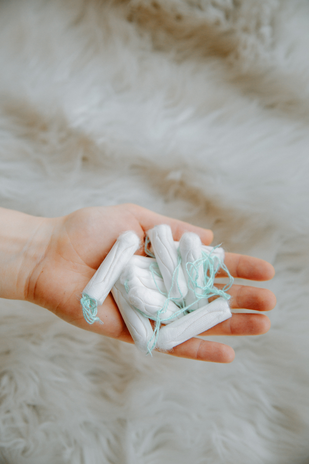About half of the world’s population is composed of individuals who menstruate once a month on average, many of whom turn to disposable tampons for their menstrual needs. Compounded to the extent to which it is used, the single-use plastic product causes significant harm to the environment.
Starting with the first stage of the product’s life cycle, the extraction of the tampon’s raw materials and the fabrication of its primary components–cotton, rayon and plastics–already sustain non-ecological practices.
-
The production of cotton uses ridiculous amounts of water and produces soil degradation and water and field contamination from the usage of agrochemicals.
2. The production of rayon, an artificial textile made from purified plant cellulose (e.g. wood pulp or cotton) and chemicals involves the release of said chemicals, specifically carbon disulphide, into the air.
-
The production of plastic involves the extraction of fossil fuels, carbon-rich materials that have devastating effects on the environment, notably climate change.
After reaching the manufacturing facilities, leaving an additional carbon footprint in transportation, the tampons are assembled then individually wrapped in a plastic envelope and collectively packaged in a cardboard box.
For a manufacturing process that sustains the use of such large amounts of plastic, you would think the product would last more than a couple of hours. Unfortunately, at the usage stage, the single-use product can only serve its purpose for four to eight hours on average.
At the disposal stage, the wrapper and the applicator must be thrown in the garbage bin, as the type of plastic used and the existing sanitary guidelines regarding the wrapper and the applicator respectively restrict them from being recycled. Eventually, the absorbent core must also be thrown out in the trash. The only recyclable item is the cardboard box packaging.
Evidently, the disposal stage causes monumental environmental burdens, such as:
-
Soil pollution:
While the cotton will take around one to five months to degrade in the landfill, rayon will take decades and the plastic components will take up to hundreds of years. Plastic components in particular represent the main issue as they release toxic substances into the soil and decompose into microplastic particles that infiltrate the food chain.
-
Air pollution:
During their overlong degradation process, plastic components are releasing greenhouse gases, polluting the air some more.
-
Water pollution:
Tampons are contaminating water; the result of millions of people flushing them down the toilet. In fact, clogged waterways sometimes lead to wastewater overflow that makes its way to larger bodies of water. Back in 2015, the NGO Ocean Conservancy amassed nearly 28,000 used tampons and applicators on beaches around the world in one day! Not only is the water being contaminated, but the presence of microplastics in the water is threatening ecosystems.
The environmental impact to lifetime ratio of plastic tampons is terribly unbalanced. As handy as they might be, they are not worth the damage they cause to the planet.
What can you do to help?
Ditch plastic tampons!
Numerous other, better, options exist, ranging from disposable tampons composed of cardboard applicators to organic tampons free of applicators, to reusable menstrual cups. By simply substituting plastic tampons for a more sustainable menstrual product, you are relieving the Earth of voluminous amounts of plastics.



